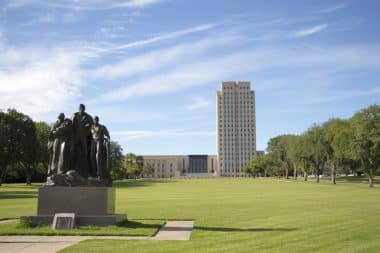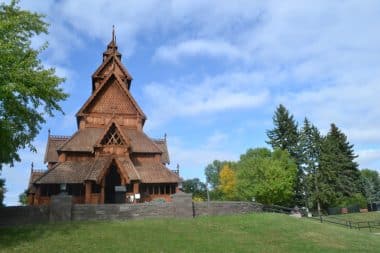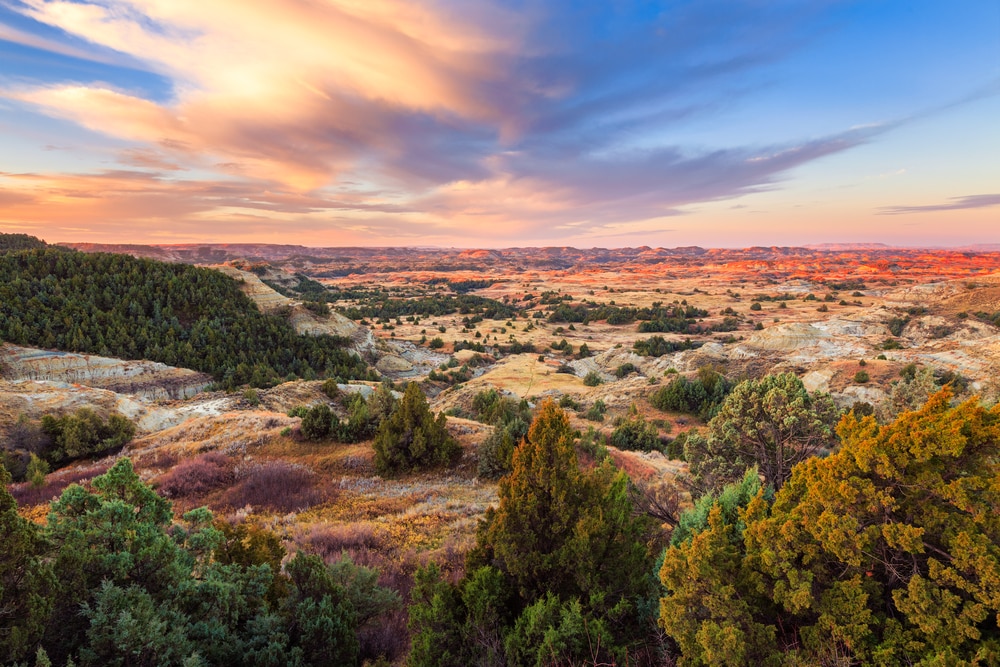The US state of North Dakota is located in the far north of the USA on the Canadian border. Due to its geographical location, this state has a rather cool climate. North Dakota was named after a Native American tribe. The Dakota tribe, which has lived in the area of present-day North Dakota since time immemorial, and served as the namesake for the US state, belongs to the Sioux Indians. North Dakota is considered very sparsely populated, but this does not detract from the state’s attractiveness for tourists. Rather the opposite. Because if you long for peace and solitude, want to find out about the history and culture of the North American natives or experience endless expanses in Theodore Roosevelt National Park, this is the place for you.
Among bison, mustangs and coyotes in Theodore Roosevelt National Park
Theodore Roosevelt National Park is named after the 26th President of the United States. He loved the region in which today’s park is located so much that he owned a ranch there, the Elkhorn Ranch, which he often visited to relax. Remains of the ranch can still be visited today. It seems a little unusual for a national park that Theodore Roosevelt National Park is not a contiguous area, but three parks that have been merged into one, so to speak.
Visually and scenically, you feel like you’ve been transported to a Wild West movie, because the national park consists primarily of wasteland and badlands. These landscapes are ultimately what Westerns refer to as the wide prairie. If you want, you can explore Theodore Roosevelt National Park extensively on foot, because there are no less than 150 kilometers of well-signposted hiking trails to explore here. However, the park is still home to American wild horses, also known as mustangs. If you want to get particularly close to them, you can take part in a guided excursion on horseback.
Another highlight are the bison, once extinct here, but reintroduced in the 1950s, which were hunted by the Indians in earlier times and served as their diet and clothing. The best way to soak up the atmosphere of the park is to spend a night under the stars. Spending the night in the park is no problem, because there are a variety of campsites.
Fargo: The secret capital of the US state of North Dakota

Fargo is not the capital of the state of North Dakota, that would be Bismarck, but with around 120,000 inhabitants it is the largest city in the state. In addition, the cultural heart of North Dakota beats here, which is why a visit to Fargo should not be missed if you are ever in North Dakota. Among locals, Fargo is considered the secret capital of North Dakota. The city is particularly known for its lively art scene.
The Plains Art Museum exhibits about 3,000 works of art, mainly by contemporary artists. Many of them are of Indian origin. In addition, there are also artistic highlights by European art greats, such as Salvador Dali’s, to see. However, the often breathtaking works of art are not only on display in the premises of the museum itself. Many of them also hang in chic craft beer bars, shops or restaurants in downtown Fargo. If you want to get an idea of the life of the pioneers in the North of America, Bonanzaville is the right place for you. This is a pioneer village true to the original, in which there is also a thematically appropriate museum.
Unique, the National Buffalo Museum
The National Buffalo Museum in Jamestown is one of those kinds of museums that you won’t find on every corner. Of course, this has to do with his exhibition focus, the bison. For the Native Americans of North Dakota, the bison, and also the hunting of them, were of utmost importance. The museum explains all the details about the importance and history of bison in the region. In addition, stuffed bison and original exhibits from the times of bison hunting can be seen. The National Buffalo Museum is housed on the grounds of an open-air museum. In the Frontier Village open-air museum, you can travel back in time to the 19th century, because all the buildings there date back to this time. They are the remains of a village with residential and administrative buildings as well as shops.
In the footsteps of Scandinavian immigrants

In the American state of North Dakota, the Scandinavian community is still strongly represented today. Once upon a time, many Scandinavians came to this area as pioneers. Among other things, they have brought with them the tradition of Scandinavian stave churches. The most famous specimen in North Dakota can be seen in the Scandinavian Heritage Park in Minota. In addition, several statues of famous Scandinavians are gathered here. The park’s walking paths also lead past Danish windmills, a museum where you can learn about the tradition of immigrants from Denmark, Norway, Sweden, Finland and Iceland, as well as a 27-metre-high Swedish wooden Dala horse.


